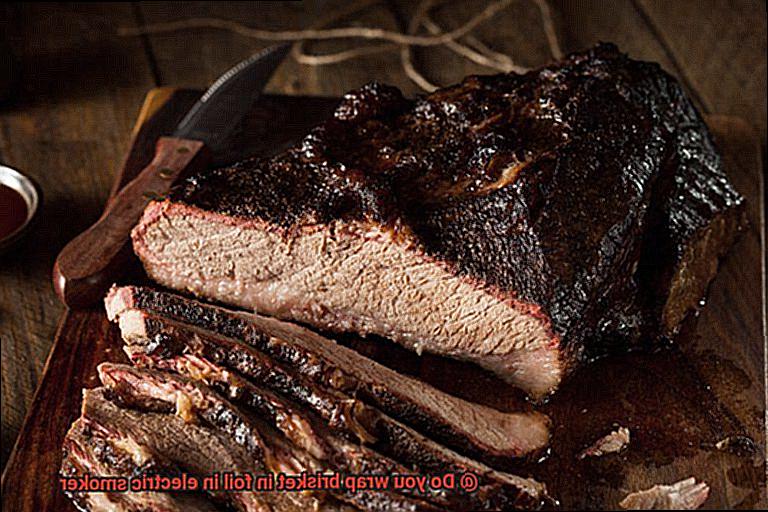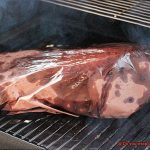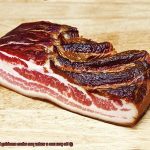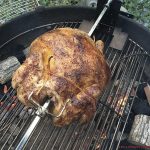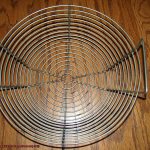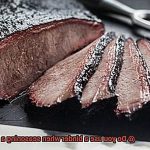Brisket is the king of smoked meats, and for good reason. This tough cut of beef is packed with flavor that only gets better when cooked low and slow. But if you’re smoking brisket in an electric smoker, you might be wondering whether to wrap it in foil or not.
The debate between pitmasters on this topic is fierce. Some swear by wrapping brisket in foil during the smoking process, claiming that it tenderizes the meat and keeps it moist while also speeding up cooking time. Others argue that wrapping brisket in foil is a mistake, as it prevents the bark from forming and can make the meat too soft.
So, which side should you take? In this blog post, we’ll explore both methods in-depth so you can make an informed decision. We’ll cover the pros and cons of wrapping your brisket in foil during smoking versus leaving it unwrapped to develop a crunchy exterior. By the end of this post, you’ll have all the information you need to smoke your best brisket yet.
Contents
The Pros of Wrapping Brisket in Foil
As an electric smoker aficionado, you may have pondered the age-old question of whether to wrap your brisket in foil or not. Wrapping brisket in foil has a multitude of benefits that are worth exploring. Here are some of the advantages of wrapping brisket in foil:
- Retains Moisture: Wrapping your brisket in foil helps trap the natural juices that can evaporate and dry out the meat when left uncovered. The result? A moist and tender brisket that melts in your mouth.
- Speeds Up Cooking Process: Wrapping brisket in foil can help to create a more even cooking environment, ultimately leading to faster cook times. This is especially important for those who don’t have time to wait around for hours on end.
- Adds Flavor: By adding additional ingredients like herbs, spices, or even beer or apple juice to the foil packet before sealing it up, you can infuse your brisket with a unique flavor profile that’ll tantalize your taste buds.
While there are certainly some downsides to wrapping brisket in foil (such as potentially sacrificing a crispy bark), for many people, the benefits outweigh the drawbacks. Ultimately, whether or not you choose to wrap your brisket in foil will depend on your personal preferences and cooking style.
If you prefer a moist and tender brisket with less bark, then wrapping it in foil may be the way to go. But if you want a smokier flavor and a crispy bark, then skip the foil and let the brisket cook unwrapped for the duration of the smoking process.
The Cons of Wrapping Brisket in Foil
Wrapping your brisket in foil is a contentious issue within the smoking community, and it’s essential to understand both the pros and cons of this method before deciding if it’s right for you.
One of the most significant cons of wrapping brisket in foil is that it can lead to a loss of bark, the crispy and delicious exterior of the meat. When you wrap the brisket in foil, moisture becomes trapped inside, causing the bark to soften, which can be a significant disappointment for those who love a crunchy texture. If you’re looking to achieve that perfect crispy bark, then skipping the foil might be your best bet.
Another downside of wrapping brisket in foil is that it can result in a steamed texture rather than a smoky one. One of the main reasons people smoke meat is for that delicious smoky flavor, but wrapping the brisket in foil traps in moisture, leading to a more tender texture at the cost of that smoky taste. If you’re someone who loves that traditional smoky flavor profile, then avoid wrapping your brisket in foil.
Wrapping brisket in foil can also extend cooking time, which can be inconvenient if you’re cooking for a large group or have other dishes to prepare. While some argue that this leads to a more tender final product, others may find it frustrating to wait longer for their brisket to finish cooking.
Lastly, wrapping brisket in foil can make it difficult to monitor the meat’s internal temperature accurately. Foil creates an insulated environment around the meat, making it harder to tell when it’s cooked correctly. This can lead to overcooking or undercooking the brisket and potentially ruining your meal.
Different Ways to Wrap Brisket in Foil
Smoking brisket is an art form that requires patience, skill, and attention to detail. One crucial aspect of the process is wrapping the meat in foil, but there are different ways to do it that can affect the final outcome of your smoked meat.
One popular method is the “Texas crutch,” which involves tightly wrapping your brisket in foil after a few hours of smoking. The foil traps moisture and heat inside, helping to break down the connective tissue and render the fat. This results in a tender and juicy brisket that is ready to be enjoyed in less time. However, some purists argue that this method can compromise the flavor and texture of the bark, which is the crispy outer layer of the meat.
Another option is to wrap your brisket in butcher paper instead of foil. This technique, known as the “Aaron Franklin method,” allows for better airflow while still protecting the meat from drying out. The paper also absorbs some of the excess moisture, resulting in a firmer bark and a smokier flavor. This method requires more attention and skill, but it can produce outstanding results.
If you prefer to skip the wrapping stage altogether, you can smoke your brisket uncovered for the entire cooking process. This method requires constant monitoring of the temperature and moisture levels to prevent the meat from drying out. However, it can result in a firmer bark and a more intense smoky flavor that many BBQ enthusiasts crave.
Tips for Wrapping Brisket in Foil
Smoking brisket in an electric smoker can be a mouthwatering experience, but it requires some skill and technique. One popular method is wrapping the meat in foil, also known as the Texas Crutch. This technique helps to retain moisture, speed up cooking time, and create a tender, juicy end result. Here are some tips and tricks for wrapping brisket in foil in an electric smoker.
Develop a Nice Bark Before Wrapping
The bark is the outer layer of meat that forms a flavorful crust during the smoking process. Wrapping too early can cause the bark to become soft and soggy. So, it’s important to wait until your brisket has developed a nice bark before wrapping it in foil. This usually takes around 4-6 hours of smoking, depending on the size of your brisket and the temperature of your smoker.
Use Heavy-Duty Aluminum Foil
When wrapping your brisket, it’s crucial to use heavy-duty aluminum foil to prevent any tears or rips that could lead to moisture loss. Make sure there are no gaps or holes where steam can escape. Wrap the brisket tightly to create a seal, keeping all the moisture inside.
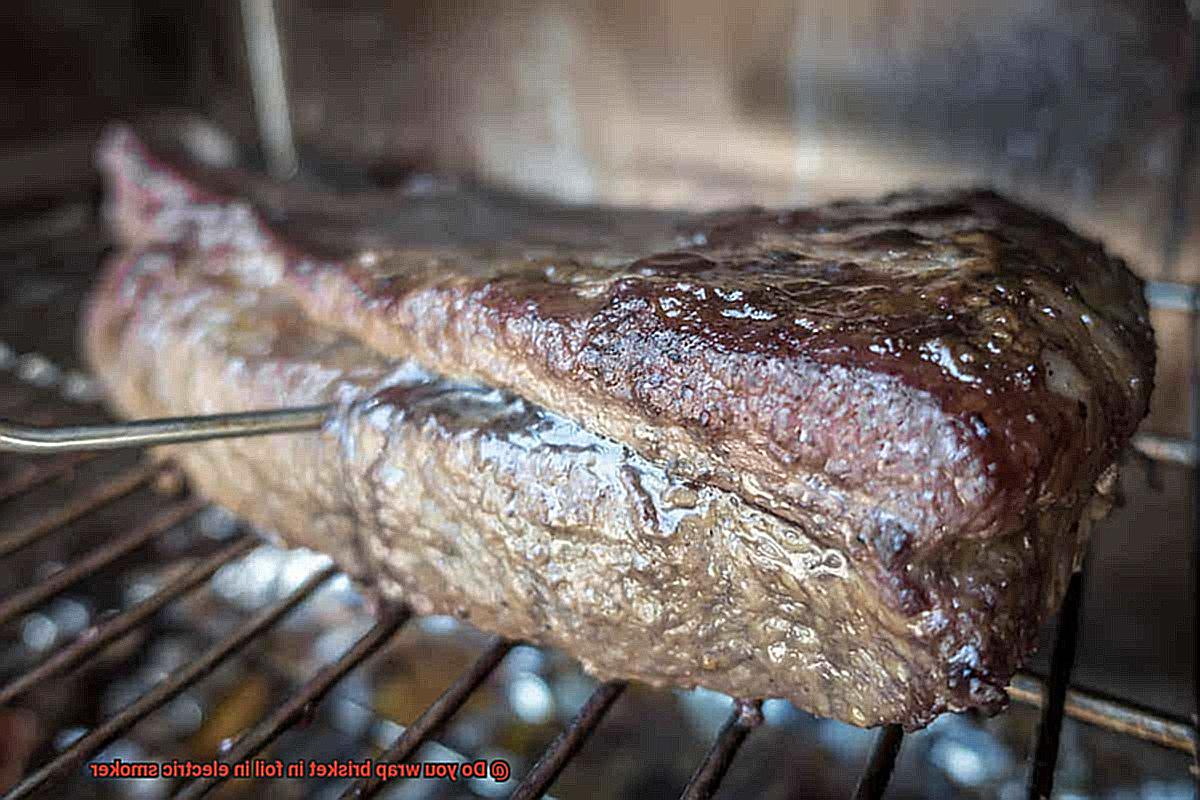
Add Liquid for Extra Moisture
Adding a small amount of liquid, such as beef broth or apple juice, to the foil packet can create steam and keep the meat moist during the cooking process. The liquid will also infuse flavor into the meat as it cooks.
Coat with Seasoning or Barbecue Sauce
Before sealing the foil packet, make sure your brisket is coated with a generous layer of seasoning or barbecue sauce. This will help infuse flavor into the meat as it continues to cook in the foil. Don’t be afraid to be generous with your seasoning; it’ll enhance the taste of your brisket.
Monitor Temperature Regularly
It’s crucial to monitor your brisket’s internal temperature regularly with a meat thermometer to ensure that it doesn’t overcook or dry out. The ideal temperature for a brisket is between 195-205°F. Once your brisket reaches this temperature, remove it from the smoker, and let it rest for at least 30 minutes. This allows the juices to redistribute throughout the meat, making it even more flavorful and juicy.
Alternate Methods for Smoking a Brisket Without Foil
As an expert in smoking brisket without foil, I’m here to share with you some exciting and flavorful alternatives.
One popular method is using a dry rub. A dry rub is a blend of spices and herbs that can be rubbed onto the meat before cooking, enhancing the flavor without adding any extra moisture. You can customize your dry rub by mixing salt, pepper, garlic powder, onion powder, paprika, and brown sugar to create a delicious blend that suits your taste buds.
Another option is spritzing your brisket with liquids during the smoking process. Spritzing helps keep the meat moist without using foil. You can use apple juice, cider vinegar, or a combination of water and Worcestershire sauce for this purpose. The result is juicy and flavorful brisket that your guests will love.
If you want to create a humid environment inside your smoker, placing a pan of water or other liquid inside is an excellent option. This will prevent the meat from drying out and keep it juicy throughout the cooking process. This method also allows for more even cooking, resulting in a perfectly cooked brisket.
Lastly, instead of using foil, you can wrap your brisket in butcher paper. Butcher paper allows for air circulation while still retaining moisture, resulting in a tender and juicy brisket that’s bursting with flavor.
How Long Should You Smoke a Brisket?
First things first, let’s discuss the key factors that determine cooking time. The size of your brisket, smoker temperature, and desired level of doneness are all critical considerations. As a general rule of thumb, aim to smoke your brisket for 1 hour and 15 minutes per pound at a steady temperature of around 225°F.
It’s important to understand that smoking a brisket is not a race. Patience is key – rushing the cooking process by increasing the smoker temperature can result in a tough and dry brisket. Trust the process and let the meat cook slowly for optimal results.
When your brisket reaches an internal temperature of around 195-205°F, it’s time to take it off the smoker. But don’t rush to carve into it just yet. Allow it to rest for at least 30 minutes so that the juices can evenly distribute throughout the meat, resulting in a more flavorful and tender brisket.
If you’re feeling adventurous, there are some additional techniques that can take your brisket to another level. Try using a dry rub or spritzing with liquids, placing a pan of water in the smoker to create humidity, or wrapping it in butcher paper for an evenly cooked and juicy brisket that will leave your guests begging for more.
What Temperature Should You Smoke a Brisket?
One of the most important factors to consider when smoking a brisket in an electric smoker is the temperature at which you should smoke it. To achieve tender, juicy meat, it is recommended to smoke your brisket at a low and slow temperature of around 225°F to 250°F.
Consistency is key when smoking a brisket. Fluctuations in temperature can cause the brisket to dry out or cook unevenly. To ensure that your brisket cooks evenly, invest in a good-quality thermometer to monitor the temperature and make adjustments as needed.
Smoking a brisket takes time, so be patient. Depending on the size of the brisket and the temperature at which it is being smoked, it can take anywhere from 8 to 14 hours to fully cook. But trust me, it’s worth the wait.
Now, let’s talk about wrapping your brisket in foil. Some people prefer to wrap their brisket in foil towards the end of the cooking process, while others prefer not to. Wrapping can help retain moisture and prevent the meat from drying out. However, it can also result in a softer bark on the outside of the meat. Whether or not you choose to wrap your brisket is ultimately up to personal taste preferences.
How to Tell When Your Brisket is Done
Smoking brisket in an electric smoker can be a daunting task, especially when it comes to determining when it’s done. But with a few tips and tricks, you can ensure that your brisket is perfectly cooked every time.
Check the Internal Temperature
The most popular and reliable method for checking if your brisket is done is by using a meat thermometer. The optimal temperature for a perfectly cooked brisket is between 195°F and 205°F. However, some pitmasters prefer to pull it off the smoker at around 190°F to prevent overcooking. To get the most accurate reading, insert the thermometer into the thickest part of the meat, away from the fat and bone.
Test the Tenderness
Another way to check if your brisket is done is by performing the “probe test.” This involves inserting a toothpick or a skewer into the thickest part of the meat and feeling how easily it slides in and out. If there’s no resistance, meaning the meat is tender and juicy, your brisket is likely done. However, if it feels tough or rubbery, it needs more time on the smoker.
Plan for Cooking Time
Cooking time and temperature can vary depending on the size and thickness of your brisket, as well as the type of smoker you’re using. A general rule of thumb is to plan for 1-1.5 hours of smoking time per pound of brisket at a temperature range of 225°F to 250°F. However, this can take longer or shorter depending on factors such as humidity, wind, and altitude.
Let it Rest
Once your brisket is done, it’s crucial to let it rest for at least 30 minutes before slicing into it. This allows the juices to redistribute throughout the meat and prevents dryness. You can wrap it in foil or a clean towel and place it in a cooler or an oven with the heat turned off to keep it warm. Finally, slice against the grain and serve with your favorite barbecue sauce and sides.
Consider Using the Texas Crutch (Optional)
Wrapping a brisket in foil during cooking can speed up the cooking process but may result in a softer bark on the outside. This is a personal preference and depends on how you like your brisket. If you’re short on time or want a more tender brisket, you can try using the “Texas crutch” by wrapping the brisket in butcher paper instead of foil.
kOBnu52QL4A” >
Conclusion
In the world of smoking brisket, there’s always a debate about whether or not to wrap it in foil. While there are pros and cons to both methods, it ultimately comes down to personal preference.
If you’re looking for a moist and tender brisket with less bark, then wrapping it in foil can be a game-changer. The foil helps retain moisture, speeds up cooking time, and adds flavor. However, it can also lead to a steamed texture and longer cooking times.
On the other hand, if you want a smokier flavor and a crispy bark, then skip the foil altogether. Letting your brisket cook unwrapped for the duration of the smoking process will give you that desired result. Plus, you won’t have to worry about losing any bark along the way.
But what if you still want that moist and tender texture without using foil? Fear not – there are alternative methods to achieve similar results. For example, you can spritz your brisket with apple juice or beer throughout the smoking process to keep it moist.
Regardless of which method you choose, monitoring your brisket’s internal temperature with a meat thermometer is crucial for optimal results. And don’t forget to let it rest before slicing into it.
In conclusion, whether or not you wrap your brisket in foil is entirely up to you.

